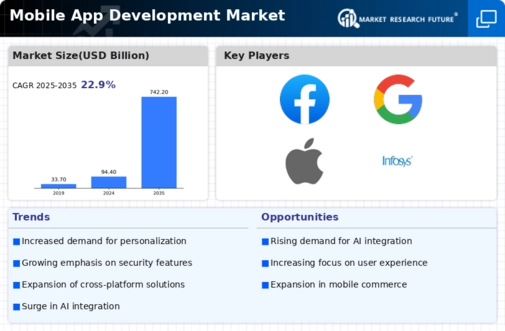-
Report prologue
-
Introduction
-
Definition
-
Scope of the study
- Research objective
- Assumptions
- Limitations
-
Market structure
-
Research Methodology
-
Research process
-
Primary research
-
Secondary research
-
Market size estimation
-
Forecast model
-
Market Dynamics
-
Drivers
-
Restraints
-
Opportunities
-
Challenges
-
Macroeconomic Indicators
-
Market factor analysis
-
Value chain analysis/Supply chain analysis
-
Porters five forces
- Bargaining Power of suppliers
- Bargaining Power of Customer
- Intensity of Competitor’s
- Threat of New Entrants
- Threat of Substitutes
-
Global Mobile Application Development Market: By Platform
-
Introduction
-
Market Sub-segments
- IOS
- Android
-
Global Mobile Application Development Market, by Application
-
Introduction
-
Market Sub-segments
- Entertainment
- Banking
- Retail
- Airlines
- E-commerce
- Education
- Government agencies
- Social Networking
- Others
-
Global Mobile Application Development Market, by Region
-
Introduction
- North America
- Europe
- Asia-Pacific
- Middle East & Africa
-
Competitive landscape
-
Introduction
- Mergers & Acquisitions
- Collaborations
- Releases/New Product launches
- Other (Expansion/ Updates/Partnerships)
-
Company profile
-
Facebook, Inc. (U.S.)
- Company Overview
- Product/Business Segment Overview
- Financials
- Key Developments
-
Google, Inc. (U.S.)
- Company Overview
- Product/Business Segment Overview
- Financials
- Key Developments
-
Microsoft Corporation (U.S.)
- Company Overview
- Product/Business Segment Overview
- Financials
- Key Developments
-
IBM corporation (U.S.)
- Company Overview
- Product/Business Segment Overview
- Financials
- Key Developments
-
Apple, Inc. (U.S.)
- Company Overview
- Product/Business Segment Overview
- Financials
- Key Developments
-
Amazon, Inc. (U.S.)
- Company Overview
- Product/Business Segment Overview
- Financials
- Key Developments
-
Kony, Inc. (U.S.)
- Company Overview
- Product/Business Segment Overview
- Financials
- Key Developments
-
Verivo software, Inc. (U.S.)
- Company Overview
- Product/Business Segment Overview
- Financials
- Key Developments
-
Infosys, Ltd. (India)
- Company Overview
- Product/Business Segment Overview
- Financials
- Key Developments
-
Wipro Corporation (India)
- Company Overview
- Product/Business Segment Overview
- Financials
- Key Developments
-
MRFR Conclusion
-
Appendix
-
List of Figures
-
Research Process
-
Drivers Of Global Mobile Application Development Market
-
Global Mobile Application Development Market: By Platform (%)
-
Global Mobile Application Development Market: By Application (%)
-
Global Mobile Application Development Market Share By Region 2020-2027 (%)
-
North America Mobile Application Development Market, By Platform (%)
-
North America Mobile Application Development Market, By Application (%)
-
North America Mobile Application Development Market Share By Country 2022-2030 (%)
-
Europe Mobile Application Development Market, By Platform (%)
-
Europe Mobile Application Development Market, By Application (%)
-
Europe Mobile Application Development Market Share By Country 2022-2030 (%)
-
Asia-Pacific Mobile Application Development Market, By Platform (%)
-
Asia-Pacific Mobile Application Development Market, By Application (%)
-
Asia-Pacific Mobile Application Development Market Share By Country 2022-2030 (%)
-
Row Mobile Application Development Market, By Platform (Usd Billion)
-
Row Mobile Application Development Market Share By Country 2022-2030 (%)
-
List of Tables
-
Global Mobile Application Development Market (Usd Billion)
-
Global Mobile Application Development Market, By Platform
-
Global Ios Markets, By Region
-
Global Android Markets, By Region
-
Global Mobile Application Development Market, By Application
-
Global Entertainment Market, By Region
-
Global Banking Market, By Region
-
Global Retail Market, By Region
-
Global Airline Industry Market, By Region
-
Global E-Commerce Market, By Region
-
Global Education Market, By Region
-
Global Government Agencies Market, By Region
-
Global Social Networking Market, By Region
-
Global Others Market, By Region
-
Global Mobile Application Development Market, By Region
-
North America Mobile Application Development Market, By Country
-
North America Mobile Application Development Market, By Platform
-
North America Mobile Application Development Market, By Application
-
U.S. Mobile Application Development Market, By Platform
-
U.S. Mobile Application Development Market, By Application
-
Canada Mobile Application Development Market, By Platform
-
Canada Mobile Application Development Market, By Application
-
Europe Mobile Application Development Market, By Country
-
Europe Mobile Application Development Market, By Platform
-
Europe Mobile Application Development Market, By Application
-
Germany Mobile Application Development Market, By Platform
-
Germany Mobile Application Development Market, By Application
-
France Mobile Application Development Market, By Platform
-
France Mobile Application Development Market, By Application
-
U.K. Mobile Application Development Market, By Platform
-
U.K. Mobile Application Development Market, By Application
-
Rest Of Europe Mobile Application Development Market, By Country
-
Rest Of Europe Mobile Application Development Market, By Platform
-
Rest Of Europe Mobile Application Development Market, By Application
-
Asia-Pacific Mobile Application Developmentmarket, By Country
-
Asia-Pacific Mobile Application Developmentmarket, By Platform
-
Asia-Pacific Mobile Application Developmentmarket, By Application
-
Middle East & Africa Mobile Application Development Market, By Country
-
Middle East & Africa Mobile Application Development Market, By Platform
-
Middle East & Africa Mobile Application Development Market, By Application







Leave a Comment